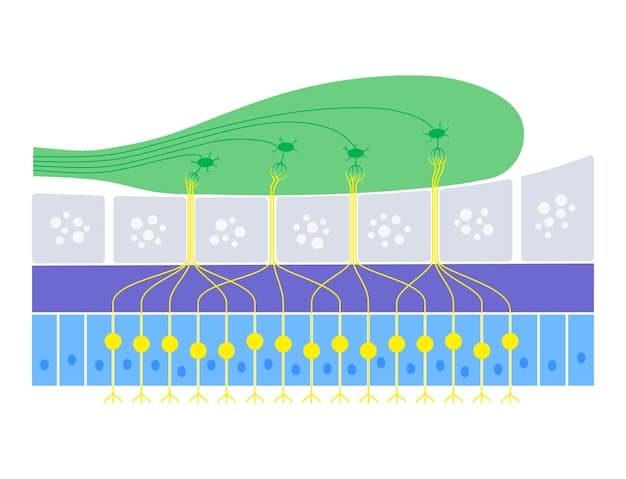Nanotechnology in US Environmental Cleanup: Progress & Risks

Nanotechnology presents a dual promise and challenge for environmental cleanup in the United States, offering innovative solutions for remediation while simultaneously raising complex questions regarding potential risks and long-term ecological impacts that require careful evaluation for responsible implementation.
The intersection of advanced science and pressing environmental concerns brings forth a fascinating, yet complex, discussion: the role of nanotechnology in US environmental cleanup: progress and potential risks. As the United States grapples with a legacy of pollution and emerging contaminants, the promise of manipulating matter at the atomic and molecular scale offers unprecedented tools. Yet, with this promise comes a series of intricate questions about the unforeseen consequences and ethical considerations that demand careful scrutiny. This exploration delves into the remarkable strides made in applying nanotechnology to environmental remediation, alongside the critical assessment of its potential drawbacks, inviting a comprehensive understanding of this evolving field.
The Dawn of Nano-Remediation: Opportunities and Innovation
Nanotechnology, the manipulation of matter on an atomic, molecular, and supramolecular scale, opens up new avenues for tackling long-standing environmental challenges in the United States. Its unique properties, such as high surface area to volume ratio and tunable reactivity, make nanomaterials exceptionally effective at interacting with pollutants at a fundamental level. This innovative approach promises more efficient and sustainable cleanup methods than traditional techniques, which often fall short in complex or widespread contamination scenarios. The sheer versatility of nanoparticles allows for targeted interventions, reducing the need for extensive excavation or harsh chemical treatments.
Across various environmental fronts, from water purification to soil remediation and air quality control, nanoparticles are demonstrating their potential. Their small size enables them to easily penetrate contaminated matrices like soil and groundwater, reaching pollutants inaccessible to larger remediation agents. This deep penetration capability is particularly valuable in sites with complex geological structures or those affected by dense non-aqueous phase liquids (DNAPLs), which are notoriously difficult to treat. The ability to customize the surface chemistry of these nanoparticles further enhances their efficacy, allowing them to selectively bind to or degrade specific contaminants, making the cleanup process more selective and less disruptive to the surrounding environment.
Water Purification Advancements
Access to clean water remains a critical challenge, and nanotechnology offers several promising solutions. Nanomaterials are being developed for advanced filtration systems, contaminant degradation, and even desalination. Their high surface area enables efficient adsorption of various pollutants, including heavy metals, organic dyes, and even microorganisms, far surpassing the capacity of conventional filter media.
- Membrane filtration: Nanopore membranes and nanocomposite membranes enhance water filtration by allowing water molecules to pass through while blocking even the smallest contaminants like viruses and bacteria.
- Adsorption: Nanomaterials such as carbon nanotubes and graphene are highly effective at adsorbing a wide range of pollutants due to their large surface area and high porosity.
- Photocatalysis: Semiconductor nanoparticles like titanium dioxide can degrade organic pollutants in water when exposed to light, breaking them down into less harmful substances.
These applications hold the potential to revolutionize water treatment facilities, providing more robust and cost-effective ways to purify water supplies. The ability of some nanoparticles to regenerate themselves or be easily recovered from the treated water further enhances their long-term applicability and economic viability. This regeneration capability is crucial for reducing waste and increasing the sustainability of water treatment processes, aligning with broader goals of circular economy principles. Furthermore, the modular nature of many nano-enabled water treatment systems allows for localized, on-demand purification, which can be particularly beneficial for rural communities or disaster relief efforts, where large-scale infrastructure is impractical or unavailable.
Soil and Groundwater Remediation
Contaminated soil and groundwater pose significant threats to both ecological health and human well-being. Traditional methods for treating these widespread issues often involve extensive excavation, which is costly and disruptive, or in-situ chemical treatments that can introduce secondary pollutants. Nanoremediation offers a less invasive and potentially more effective alternative. Zerovalent iron nanoparticles (nZVI) are a prime example, capable of degrading a variety of persistent organic pollutants and heavy metals directly in the subsurface.
- In-situ degradation: nZVI nanoparticles can dechlorinate chlorinated hydrocarbons, transform heavy metals into less mobile and toxic forms, and break down other recalcitrant organic compounds.
- Enhanced mobility: Their small size allows nanoparticles to navigate porous media effectively, reaching contaminated zones that are difficult to access with bulkier reactive agents.
- Bioremediation enhancement: Nanoparticles can also serve as electron donors or nutrient sources, stimulating the growth and activity of native microbial populations that are capable of biodegrading pollutants.
The ability of nanoparticles to remain stable and reactive within the subsurface environment for extended periods is a key advantage. This longevity, coupled with their high reactivity, means that fewer applications might be needed, leading to reduced operational costs and a smaller environmental footprint. The precision of nano-remediation also minimizes disturbance to the ecosystem, preserving soil structure and microbial diversity, which are often compromised by more aggressive conventional cleanup methods. This subtle yet powerful intervention can restore contaminated sites more holistically, promoting natural recovery processes. The ongoing research into the longevity and dispersion of these nanomaterials is crucial for ensuring their optimal performance and preventing unintended spread, thereby maximizing their beneficial impact on groundwater and soil quality.
Unpacking the Risks: Navigating the Unknowns of Nanomaterials
While the prospects of nanotechnology in environmental cleanup are compelling, a careful and critical assessment of its potential risks is equally imperative. The very properties that make nanoparticles so effective – their minuscule size, high reactivity, and novel chemical characteristics – also introduce uncertainties regarding their interaction with biological systems and the broader environment. Understanding these risks is not about denying the potential benefits, but rather about ensuring responsible development and implementation, safeguarding against unintended consequences that could undermine the very goals of environmental remediation.
The challenge lies in the novelty of these materials. Our current understanding of their behavior in complex environmental matrices, their long-term fate, and their interactions with diverse ecosystems is still developing. Unlike well-studied conventional pollutants, the journey of engineered nanoparticles through soil, water, and air, their uptake by organisms, and their potential for bioaccumulation or biomagnification are areas requiring extensive research. This lack of complete data necessitates a cautious approach, balancing innovation with rigorous scientific inquiry and robust regulatory frameworks. The complexity also extends to distinguishing between engineered nanoparticles and naturally occurring nanoscale materials, complicating detection, monitoring, and risk assessment efforts in the field. This distinction is critical for accurately attributing environmental impacts and for designing targeted regulatory measures.

Ecological Impacts and Ecotoxicity
One of the primary concerns revolves around the ecotoxicity of engineered nanoparticles. Studies have shown that certain nanoparticles, even those considered benign in bulk form, can exhibit toxic effects on various organisms at the nanoscale. These effects can range from oxidative stress and DNA damage in aquatic organisms to disruption of microbial communities vital for ecosystem health.
- Aquatic organisms: Fish, daphnia, and algae exposed to nanoparticles have shown adverse effects on growth, reproduction, and survival, depending on the type and concentration of nanoparticles.
- Soil organisms: Earthworms and soil microbes, crucial for nutrient cycling and soil fertility, can be negatively impacted by nanoparticle accumulation, potentially altering soil ecosystem function.
- Bioaccumulation: There is a concern that nanoparticles could accumulate in the food chain, leading to higher concentrations in top predators, though compelling evidence for widespread bioaccumulation is still emerging and subject to specific nanoparticle types.
The impact on microbial communities is particularly worrisome, as these microscopic entities play fundamental roles in nutrient cycling, decomposition, and overall ecosystem stability. Any disruption to these delicate balances could have cascading effects throughout the environment. Furthermore, the surface coatings and modifications applied to nanoparticles to enhance their performance in remediation might alter their environmental behavior and toxicity in unforeseen ways, necessitating comprehensive toxicological assessments not just of the core nanoparticle but also of its intended and potential degradation products. This complexity underscores the need for a holistic approach to risk assessment that considers the entire lifecycle of the nanomaterial. Understanding how nanoparticles interact with and transform within ecological systems is paramount to predicting and mitigating any adverse effects before widespread deployment.
Human Health Concerns
Beyond ecological impacts, the potential effects of engineered nanoparticles on human health are a significant area of investigation. While direct exposure during environmental cleanup applications might be limited to remediation workers, the potential for nanoparticles to become aerosolized or ingested through contaminated water or food pathways raises broader public health questions. Inhalation exposure, in particular, has garnered attention due to the ability of nanoparticles to penetrate deep into the lungs and potentially cross biological barriers.
- Inhalation risks: Studies on animal models indicate potential for lung inflammation, fibrosis, and even systemic effects following inhalation of certain nanoparticles, similar to concerns with ultrafine particulate matter.
- Dermal and oral exposure: While skin penetration is generally considered low, ingestion of contaminated water or food could lead to gastrointestinal exposure, with potential for uptake into the bloodstream.
- Long-term effects: The long-term health consequences of chronic, low-level exposure to various types of engineered nanoparticles remain largely unknown and require extensive epidemiological and toxicological research.
The unique physicochemical properties of nanoparticles, such as their high surface area and quantum effects, differentiate their biological interactions from larger particles of the same material. This means that traditional toxicology paradigms might not fully capture the risks. The absence of comprehensive long-term data on human exposure pathways and health outcomes represents a significant knowledge gap that regulators and researchers are actively working to address. Furthermore, the variability in nanoparticle composition, size, shape, and surface chemistry makes generalized risk assessments challenging, requiring substance-specific evaluations. This intricate nature of nanoparticle-biological interactions demands a precautionary approach, emphasizing thorough understanding before widespread application.
Regulatory Landscape and Ethical Considerations in the US
The rapid advancement of nanotechnology in environmental applications presents a unique challenge for regulatory bodies in the United States. Existing environmental regulations, formulated largely before the advent of engineered nanomaterials, often do not adequately address the specific characteristics and potential risks associated with these novel substances. This creates a regulatory gap, where the benefits of nano-remediation must be balanced against the imperative to protect public health and the environment without stifling innovation. The challenge lies in developing flexible yet robust frameworks that can adapt to new scientific discoveries while providing clear guidelines for responsible research, development, and deployment.
Several federal agencies, including the Environmental Protection Agency (EPA), the Food and Drug Administration (FDA), and the Occupational Safety and Health Administration (OSHA), have varying degrees of oversight concerning nanomaterials. However, their approaches are often fragmented due to the broad range of applications and the cross-cutting nature of nanotechnology. The EPA, for instance, has focused on evaluating nanomaterials under existing statutes like the Toxic Substances Control Act (TSCA), but the suitability of these frameworks for regulating materials with vastly different properties from conventional chemicals is frequently debated. This ongoing debate highlights the need for a more coordinated and proactive regulatory strategy that can keep pace with the pace of scientific discovery and commercialization.
Regulatory Frameworks and Challenges
The current regulatory landscape for nanomaterials in environmental cleanup is characterized by a patchwork of existing laws and emerging guidance documents. This can lead to uncertainty for researchers and industry, potentially hindering the widespread adoption of beneficial nano-remediation technologies or, conversely, allowing inadequately assessed materials to enter the environment.
- TSCA applicability: The EPA attempts to regulate engineered nanomaterials under TSCA, but its framework was not designed for the unique properties of nanoparticles, leading to challenges in data requirements and risk assessment.
- Research and development: While research is encouraged, clear guidelines for the safe handling, testing, and disposal of nanomaterials in experimental and pilot-scale cleanup projects are still evolving.
- Monitoring and enforcement: Developing effective methods for monitoring the release and environmental fate of nanoparticles from remediation sites, as well as enforcing compliance, remains a significant challenge due to their minuscule size and diverse forms.
The lack of specific legislation or a dedicated regulatory body for nanotechnology means that an adaptive and collaborative approach among various agencies is essential. This often involves leveraging existing regulations while simultaneously developing new policies and guidance as more scientific data become available. Transparency and public engagement are also crucial components of this regulatory process, ensuring that societal concerns are addressed and that the public has confidence in the safety evaluation of new technologies. The goal is to create a regulatory environment that fosters innovation while maintaining rigorous environmental and health safeguards, a delicate balance that requires continuous refinement and adaptability.
Ethical and Societal Implications
Beyond regulatory considerations, the deployment of nanotechnology in environmental cleanup raises profound ethical and societal questions. These include issues of equity in benefit distribution, the perception of risk by different communities, and the potential for public distrust if concerns are not adequately addressed. The “nano-divide,” referring to disparities in access to and benefits from nanotechnology, is a relevant concern, as advanced cleanup technologies might disproportionately benefit wealthier communities or lead to inequities in environmental burden. This complex interplay of science, policy, and societal values necessitates a broad-based dialogue.
- Public perception: Understanding public attitudes towards nanotechnology and addressing misperceptions or fears is crucial for gaining acceptance and support for its environmental applications.
- Environmental justice: Ensuring that the benefits of nano-remediation are equitably distributed and that potential risks do not fall disproportionately on vulnerable communities is an important ethical imperative.
- Long-term stewardship: Considerations around who is responsible for the long-term monitoring and potential remediation of engineered nanoparticles if unforeseen issues arise are critical and complex.
The ethical dimension also extends to the inherent uncertainties associated with emerging technologies. A precautionary principle, which advocates for caution in the face of potential harm even when scientific certainty is lacking, frequently arises in discussions about nanomaterials. Balancing this principle with the urgent need for effective environmental remediation solutions requires careful consideration of trade-offs and open, honest communication with all stakeholders. Engaging diverse perspectives, from environmental activists to public health experts and indigenous communities, can foster more inclusive and responsible decision-making processes. This collaborative approach recognizes that technological solutions must be integrated within a broader societal context, considering human values and diverse priorities.
Case Studies: Successes and Learning Opportunities
Examining real-world applications of nanotechnology in environmental cleanup provides invaluable insights into its capabilities and the challenges encountered during implementation. While many projects are still in the pilot or demonstration phase, several case studies in the United States illustrate the diverse ways in which nanomaterials are being utilized and the lessons being learned. These examples are crucial for refining deployment strategies, improving predictive models for environmental fate, and informing future regulatory decisions. Each case, whether a resounding success or a challenging learning experience, contributes to the growing body of knowledge necessary for the responsible advancement of nano-remediation.
From contaminated groundwater plumes to heavy metal-laden soils, the applications vary widely, reflecting the versatility of nanotechnology. These projects often involve collaborations between academic institutions, government agencies, and private industry, highlighting the interdisciplinary nature of this field. The data collected from these field trials are vital for moving beyond laboratory-scale demonstrations and proving the efficacy and safety of nano-remediation in complex, real-world environments. This practical experience is also instrumental in identifying any unforeseen issues related to deployment logistics, material transport, and long-term performance, ensuring that theoretical potentials translate into practical successes. Such comprehensive data collection is essential for building confidence among stakeholders and paving the way for broader adoption.

Groundwater Remediation with nZVI
One of the most widely studied and deployed applications of nanotechnology for environmental cleanup involves the use of zerovalent iron nanoparticles (nZVI) for the remediation of contaminated groundwater. Specifically, nZVI has shown significant promise in degrading chlorinated solvents like trichloroethylene (TCE) and perchloroethylene (PCE), common groundwater pollutants from industrial activities and landfills.
- Naval Air Station Jacksonville, FL: A notable early application involved injecting nZVI into a TCE-contaminated groundwater plume, showing significant reduction in contaminant concentrations over time, demonstrating the potential for in-situ treatment.
- Former Chemical Plant Site, NJ: Here, nZVI was used to treat hexavalent chromium, a highly toxic heavy metal. The nanoparticles effectively reduced it to less toxic trivalent chromium, immobilizing it and preventing further spread.
- Advantages observed: These field trials have highlighted nZVI’s ability to rapidly degrade pollutants, be applied in-situ (reducing disturbance), and provide a long-lasting treatment effect due to their continued reactivity in anaerobic conditions.
While generally successful, these case studies also underscore the importance of careful site characterization to ensure optimal dispersion and contact between the nanoparticles and the contaminants. Challenges such as aggregation of nanoparticles and their transport limitations in certain geological formations have emerged, prompting ongoing research into surface modifications and delivery methods to enhance their efficiency. The long-term monitoring of these sites is also crucial to confirm sustained remediation and to track the fate of the nanoparticles themselves, addressing concerns about their potential residual effects. This systematic evaluation ensures that each deployment serves as a robust learning opportunity, refining the efficacy and safety protocols for future applications.
Emerging Contaminants and Air Quality
Beyond traditional pollutants, nanotechnology is also being explored for addressing emerging contaminants, such as pharmaceuticals and personal care products (PPCPs), and improving outdoor and indoor air quality. These applications often involve photocatalytic nanoparticles or advanced sorbents, showcasing the breadth of nano-remediation technologies.
- Sorbent materials for PFAS: Per- and polyfluoroalkyl substances (PFAS) are a growing concern. Nanomaterials with enhanced adsorption capabilities are being developed to capture these “forever chemicals” from water.
- TiO2 photocatalysis for air purification: Titanium dioxide (TiO2) nanoparticles integrated into building materials or coatings can break down airborne pollutants like nitrogen oxides (NOx) and volatile organic compounds (VOCs) under sunlight.
- Biofilter enhancement: Nanomaterials are being investigated to augment the performance of biofilters used in waste treatment to enhance the removal of odor-causing compounds and other air pollutants.
These applications, while often in earlier stages of development compared to nZVI for groundwater, demonstrate the forward-thinking nature of nano-remediation. The challenges in these areas include ensuring the long-term stability and reusability of the nanomaterials, as well as optimizing their efficiency under variable environmental conditions. Furthermore, for air quality applications, the potential for unintended release of nanoparticles into the atmosphere from coated surfaces needs to be rigorously assessed. The innovative approaches for addressing these complex contaminants highlight the adaptive potential of nanotechnology, capable of tackling new environmental threats as they emerge. Continuous research and development, coupled with robust environmental impact assessments, will be key to bringing these promising solutions to widespread industrial and domestic use.
Future Outlook: Promises and Prerequisites
The trajectory of nanotechnology in environmental cleanup in the United States suggests a future brimming with potential, yet also demanding continued caution and strategic foresight. As scientific understanding deepens and technological capabilities advance, we can anticipate more sophisticated, targeted, and sustainable remediation solutions. However, realizing this future hinges not solely on scientific breakthroughs but also on the parallel development of robust regulatory frameworks, comprehensive risk assessment methodologies, and sustained public engagement. The path forward requires a balance between innovation and responsibility, ensuring that the benefits of nanotechnology are maximized while its potential drawbacks are minimized.
The integration of nanotechnology with other emerging technologies, such as artificial intelligence (AI) and biotechnology, holds particular promise. AI could optimize nanoparticle synthesis and deployment strategies, predicting their behavior in complex environments with greater accuracy. Biotechnology, combined with nanotechnology, could lead to synergistic approaches, where nanomaterials enhance biological remediation processes or act as delivery vehicles for targeted microbial agents. This interdisciplinary convergence could unlock new levels of efficiency and effectiveness, tackling environmental challenges that currently seem intractable. Yet, as with any advanced technology, careful consideration of societal implications and ethical guidelines will be paramount to ensure that these powerful tools are wielded responsibly and beneficially.
Optimizing Performance and Minimizing Risk
The future progress of nano-remediation depends heavily on continued research aimed at enhancing the performance of nanomaterials while simultaneously reducing any associated risks. This involves developing new types of nanoparticles with tailored properties and improving delivery mechanisms to ensure they reach their targets effectively and safely.
- Smart nanomaterials: Research is focused on creating “smart” nanoparticles that can respond to environmental cues, such as pH changes or contaminant concentrations, to optimize their activity and duration.
- Sustainable synthesis: Developing greener, more cost-effective methods for synthesizing nanoparticles, possibly from renewable resources, is crucial for widespread adoption.
- Predictive toxicology: Advanced computational models and high-throughput screening methods are being developed to more accurately predict the environmental fate and toxicological effects of novel nanoparticles before costly large-scale testing.
A key area of development will be improving the ability to track and recover nanoparticles after deployment, addressing concerns about their long-term environmental fate. This could involve magnetic nanoparticles that can be retrieved using magnetic fields or biodegradable nanoparticles that safely break down into inert components after their function is served. Such advancements would significantly enhance the safety profile and public acceptance of nano-remediation technologies. The evolution of more robust and comprehensive lifecycle assessments for nanomaterials will also guide their development and application, ensuring minimal environmental impact from production to disposal. This holistic approach is essential for realizing the full, sustainable potential of nanotechnology in tackling environmental pollution in the long run.
Policy, Collaboration, and Public Engagement
The successful and responsible integration of nanotechnology into US environmental cleanup efforts necessitates strong policy frameworks, sustained interagency collaboration, and active public engagement. Without these pillars, scientific advancements risk being hampered by regulatory uncertainty, public distrust, or ethical missteps. This multi-faceted approach acknowledges that technology alone is insufficient; societal readiness and robust governance are equally vital components for successful implementation.
- Harmonized regulations: Developing consistent and clear regulatory guidelines across federal and state levels will provide certainty for innovators and ensure uniform safety standards.
- International cooperation: Collaborating with international partners on research, risk assessment, and best practices for nanomaterial deployment can accelerate learning and prevent redundant efforts.
- Transparent communication: Open dialogue with the public about both the benefits and risks of nanotechnology, addressing concerns with factual information, is essential for building trust and gaining social license to operate.
Investing in public education and scientific literacy about nanotechnology will empower communities to engage meaningfully in discussions about its application. Furthermore, integrating ethical considerations and environmental justice principles into the early stages of research and development can help prevent disproportionate impacts on vulnerable populations. The establishment of clear legal frameworks for liability and long-term stewardship will also be crucial as these technologies mature. Ultimately, the future of nanotechnology in environmental cleanup in the US will be shaped by a concerted effort that transcends scientific laboratories, extending into the realms of policy, public discourse, and collaborative governance, ensuring that this powerful tool serves humanity and the planet responsibly.
| Key Point | Brief Description |
|---|---|
| 🧪 Nano-Remediation Potential | Offers innovative and efficient solutions for water, soil, and air pollution cleanup. |
| ⚠️ Potential Risks | Concerns include ecotoxicity, human health impacts, and unknown long-term environmental fate. |
| ⚖️ Regulatory & Ethical Challenges | Existing regulations are inadequate; ethical issues like equitable benefit distribution arise. |
| 🔮 Future Outlook | Promises smarter materials and integrated solutions, requiring collaboration and public trust. |
Frequently Asked Questions About Nanotechnology in Environmental Cleanup
▼
Nanotechnology’s primary advantage lies in its ability to manipulate matter at the atomic and molecular level, enabling highly efficient and targeted interactions with pollutants. Nanomaterials possess unique properties like high surface area and tunable reactivity, which allow for more effective degradation or sequestration of contaminants compared to conventional methods. This often results in faster cleanup times and reduced environmental disturbance during remediation processes.
▼
The main environmental risks stem from the novel properties of nanomaterials, which can lead to ecotoxicity concerns. These include potential adverse effects on aquatic and soil organisms, disruption of vital microbial communities, and the risk of bioaccumulation within food chains. Long-term environmental fate and the potential for unintended dispersion of nanoparticles in ecosystems remain areas requiring significant research and careful monitoring to mitigate risks effectively.
▼
Yes, human health concerns primarily involve potential exposure pathways, especially inhalation of airborne nanoparticles during application or if they become aerosolized from treated sites. Studies suggest possibilities of lung inflammation or systemic effects, though widespread direct public exposure is generally low. The long-term health consequences of chronic, low-level exposure to various engineered nanoparticles are still largely unknown, necessitating more research and cautious occupational safety protocols.
▼
Regulation of nanotechnology in US environmental cleanup is currently a complex and evolving landscape. No single legislation specifically targets nanomaterials; instead, existing laws like the Toxic Substances Control Act (TSCA) are being adapted. This creates challenges due to the unique properties of nanoparticles, leading to regulatory gaps and the need for new policies and interagency collaboration to ensure safety while fostering innovation in this rapidly advancing field.
▼
Future developments in nano-remediation are expected to include the creation of “smart” nanomaterials that can self-regulate or respond to specific environmental cues. Enhanced recovery and biodegradability features will also be a focus, minimizing post-treatment risks. Integration with AI and biotechnology could further optimize deployment and effectiveness. Sustainable synthesis methods are also a key area of research, aiming for greener production processes and lower costs for broader adoption.
Conclusion
The journey of nanotechnology in US environmental cleanup is a compelling narrative of scientific innovation confronting complex societal and ecological challenges. From its extraordinary promise in purifying water and remediating contaminated sites to the intricate layers of potential risks and regulatory uncertainties, this field embodies the multifaceted nature of emerging technologies. While the progress has been substantial, demonstrating the unique capabilities of nanomaterials to address otherwise intractable pollution problems, the need for rigorous scientific inquiry, robust ethical consideration, and transparent public engagement remains paramount. As we look to the future, the responsible advancement of nano-remediation will depend on a delicate balance: fostering groundbreaking research while meticulously navigating the unknowns, ensuring that these powerful atomic-scale tools serve to enhance, rather than inadvertently harm, our shared environment and public health. This ongoing dialogue and collaborative effort will ultimately define the true impact and legacy of nanotechnology in shaping a cleaner, more sustainable future for the United States.





